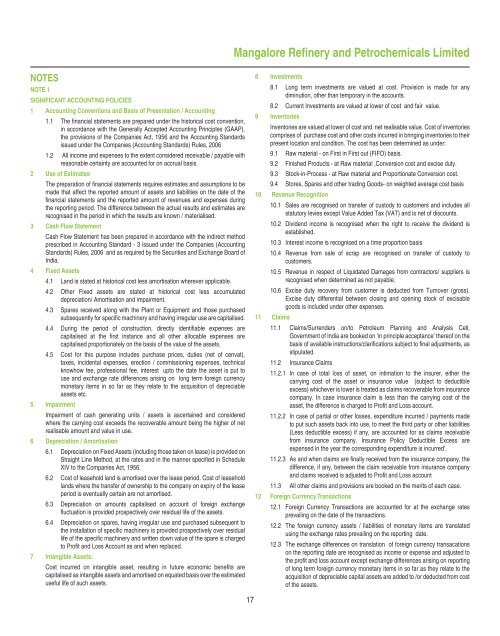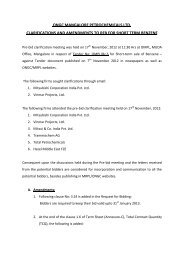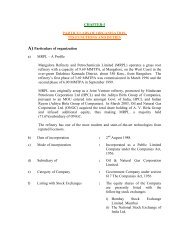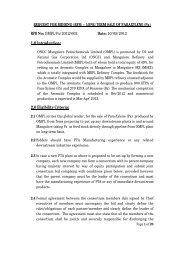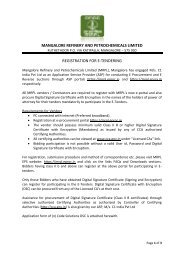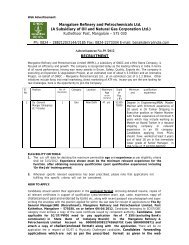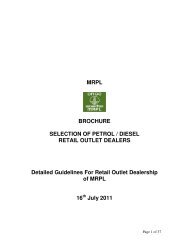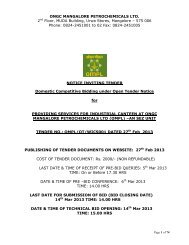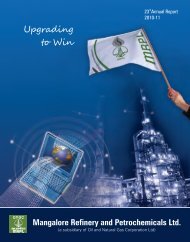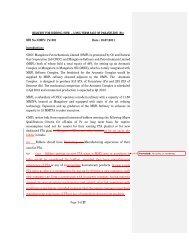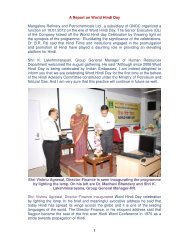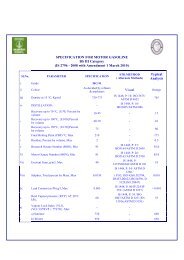Annual Report for 2012-13 - Mangalore Refinery and ...
Annual Report for 2012-13 - Mangalore Refinery and ...
Annual Report for 2012-13 - Mangalore Refinery and ...
You also want an ePaper? Increase the reach of your titles
YUMPU automatically turns print PDFs into web optimized ePapers that Google loves.
<strong>Mangalore</strong> <strong>Refinery</strong> <strong>and</strong> Petrochemicals Limited<br />
NOTES<br />
NOTE 1<br />
SIGNIFICANT ACCOUNTING POLICIES<br />
1 Accounting Conventions <strong>and</strong> Basis of Presentation / Accounting<br />
1.1 The fi nancial statements are prepared under the historical cost convention,<br />
in accordance with the Generally Accepted Accounting Principles (GAAP),<br />
the provisions of the Companies Act, 1956 <strong>and</strong> the Accounting St<strong>and</strong>ards<br />
issued under the Companies (Accounting St<strong>and</strong>ards) Rules, 2006<br />
1.2 All income <strong>and</strong> expenses to the extent considered receivable / payable with<br />
reasonable certainty are accounted <strong>for</strong> on accrual basis.<br />
2 Use of Estimates<br />
The preparation of fi nancial statements requires estimates <strong>and</strong> assumptions to be<br />
made that affect the reported amount of assets <strong>and</strong> liabilities on the date of the<br />
fi nancial statements <strong>and</strong> the reported amount of revenues <strong>and</strong> expenses during<br />
the reporting period. The difference between the actual results <strong>and</strong> estimates are<br />
recognised in the period in which the results are known / materialised.<br />
3 Cash Flow Statement<br />
Cash Flow Statement has been prepared in accordance with the indirect method<br />
prescribed in Accounting St<strong>and</strong>ard - 3 issued under the Companies (Accounting<br />
St<strong>and</strong>ards) Rules, 2006 <strong>and</strong> as required by the Securities <strong>and</strong> Exchange Board of<br />
India.<br />
4 Fixed Assets<br />
4.1 L<strong>and</strong> is stated at historical cost less amortisation wherever applicable.<br />
4.2 Other Fixed assets are stated at historical cost less accumulated<br />
depreciation/ Amortisation <strong>and</strong> impairment.<br />
4.3 Spares received along with the Plant or Equipment <strong>and</strong> those purchased<br />
subsequently <strong>for</strong> specifi c machinery <strong>and</strong> having irregular use are capitalised.<br />
4.4 During the period of construction, directly identifi able expenses are<br />
capitalised at the fi rst instance <strong>and</strong> all other allocable expenses are<br />
capitalised proportionately on the basis of the value of the assets.<br />
4.5 Cost <strong>for</strong> this purpose includes purchase prices, duties (net of cenvat),<br />
taxes, incidental expenses, erection / commissioning expenses, technical<br />
knowhow fee, professional fee, interest upto the date the asset is put to<br />
use <strong>and</strong> exchange rate differences arising on long term <strong>for</strong>eign currency<br />
monetary items in so far as they relate to the acquisition of depreciable<br />
assets etc.<br />
5 Impairment<br />
Impairment of cash generating units / assets is ascertained <strong>and</strong> considered<br />
where the carrying cost exceeds the recoverable amount being the higher of net<br />
realisable amount <strong>and</strong> value in use.<br />
6 Depreciation / Amortisation<br />
6.1 Depreciation on Fixed Assets (including those taken on lease) is provided on<br />
Straight Line Method, at the rates <strong>and</strong> in the manner specifi ed in Schedule<br />
XIV to the Companies Act, 1956.<br />
6.2 Cost of leasehold l<strong>and</strong> is amortised over the lease period. Cost of leasehold<br />
l<strong>and</strong>s where the transfer of ownership to the company on expiry of the lease<br />
period is eventually certain are not amortised.<br />
6.3 Depreciation on amounts capitalised on account of <strong>for</strong>eign exchange<br />
fl uctuation is provided prospectively over residual life of the assets.<br />
6.4 Depreciation on spares, having irregular use <strong>and</strong> purchased subsequent to<br />
the installation of specifi c machinery is provided prospectively over residual<br />
life of the specifi c machinery <strong>and</strong> written down value of the spare is charged<br />
to Profi t <strong>and</strong> Loss Account as <strong>and</strong> when replaced.<br />
7 Intangible Assets:<br />
Cost incurred on intangible asset, resulting in future economic benefi ts are<br />
capitalised as intangible assets <strong>and</strong> amortised on equated basis over the estimated<br />
useful life of such assets.<br />
8 Investments<br />
8.1 Long term investments are valued at cost. Provision is made <strong>for</strong> any<br />
diminution, other than temporary in the accounts.<br />
8.2 Current Investments are valued at lower of cost <strong>and</strong> fair value.<br />
9 Inventories<br />
Inventories are valued at lower of cost <strong>and</strong> net realisable value. Cost of inventories<br />
comprises of purchase cost <strong>and</strong> other costs incurred in bringing inventories to their<br />
present location <strong>and</strong> condition. The cost has been determined as under:<br />
9.1 Raw material - on First in First out (FIFO) basis.<br />
9.2 Finished Products - at Raw material ,Conversion cost <strong>and</strong> excise duty.<br />
9.3 Stock-in-Process - at Raw material <strong>and</strong> Proportionate Conversion cost.<br />
9.4 Stores, Spares <strong>and</strong> other trading Goods- on weighted average cost basis<br />
10 Revenue Recognition<br />
10.1 Sales are recognised on transfer of custody to customers <strong>and</strong> includes all<br />
statutory levies except Value Added Tax (VAT) <strong>and</strong> is net of discounts.<br />
10.2 Dividend income is recognised when the right to receive the dividend is<br />
established.<br />
10.3 Interest income is recognised on a time proportion basis<br />
10.4 Revenue from sale of scrap are recognised on transfer of custody to<br />
customers.<br />
10.5 Revenue in respect of Liquidated Damages from contractors/ suppliers is<br />
recognised when determined as not payable.<br />
10.6 Excise duty recovery from customer is deducted from Turnover (gross).<br />
Excise duty differential between closing <strong>and</strong> opening stock of excisable<br />
goods is included under other expenses.<br />
11 Claims<br />
11.1 Claims/Surrenders on/to Petroleum Planning <strong>and</strong> Analysis Cell,<br />
Government of India are booked on ‘in principle acceptance’ thereof on the<br />
basis of available instructions/clarifi cations subject to fi nal adjustments, as<br />
stipulated.<br />
11.2 Insurance Claims<br />
11.2.1 In case of total loss of asset, on intimation to the insurer, either the<br />
carrying cost of the asset or insurance value (subject to deductible<br />
excess) whichever is lower is treated as claims recoverable from insurance<br />
company. In case insurance claim is less than the carrying cost of the<br />
asset, the difference is charged to Profi t <strong>and</strong> Loss account.<br />
11.2.2 In case of partial or other losses, expenditure incurred / payments made<br />
to put such assets back into use, to meet the third party or other liabilities<br />
(Less deductible excess) if any, are accounted <strong>for</strong> as claims receivable<br />
from insurance company. Insurance Policy Deductible Excess are<br />
expensed in the year the corresponding expenditure is incurred’.<br />
11.2.3 As <strong>and</strong> when claims are fi nally received from the insurance company, the<br />
difference, if any, between the claim receivable from insurance company<br />
<strong>and</strong> claims received is adjusted to Profi t <strong>and</strong> Loss account<br />
11.3 All other claims <strong>and</strong> provisions are booked on the merits of each case.<br />
12 Foreign Currency Transactions<br />
12.1 Foreign Currency Transactions are accounted <strong>for</strong> at the exchange rates<br />
prevailing on the date of the transactions.<br />
12.2 The <strong>for</strong>eign currency assets / liabilities of monetary items are translated<br />
using the exchange rates prevailing on the reporting date.<br />
12.3 The exchange differences on translation of <strong>for</strong>eign currency transacations<br />
on the reporting date are recognised as income or expense <strong>and</strong> adjusted to<br />
the profi t <strong>and</strong> loss account except exchange differences arising on reporting<br />
of long term <strong>for</strong>eign currency monetary items in so far as they relate to the<br />
acquisition of depreciable capital assets are added to /or deducted from cost<br />
of the assets.<br />
17


